1 In humans what organ is considered responsible for a suppl
1. In humans, what organ is considered responsible for:
a. supplying other lymphoid tissues with “uncommitted lymphocytes”
b. producing lymphocyte-stimulating hormones
c. producing hormones that enhance the maturation of disseminated lymphocytes
d. producing T-lymphocytes
2. Cells that synthesize antibody are ____________________.
3. Which of the following functions is(are) characteristic of the cellular immune system?
a. rejection of transplants
b. activation of complement
c. delayed hypersensitivity reactions
d. immunoglobulin production
9. “Immune” A and B alloantibodies differ from “natural” A and B alloantibodies in that the “immune” antibodies
a. are generally IgG, whereas naturally occurring forms are generally IgM
b. are unable to cross the placenta
c. can have their titer enhanced by incubation at cold temperature
d. are usually agglutinating antibodies
11. Which of the following statements is (are) true regarding a type 1 hypersensitivity reaction, also called anaphylactic reaction?
a. IgE is the immunoglobulin associated with it.
b. Cellular involvement includes mast cells and basophils.
c. Histamine is a chemical mediator.
d. Complement is not involved in the reaction.
14. Which of the following statements is(are) true concerning serologic titers? Example: the acute phase is 1:80, and the convalescent is 1:160 when doubling dilutions are used.
a. Each titer represents a relative, not absolute, concentration of antibody.
b. The differences between titers is sufficient to show an increase, and therefore
is evidence of a disease process.
c. Normal titers may vary according to individual or geographic locale.
d. The convalescent titer in this example is high enough by itself to be diagnostic
for a specific disease process.
15. Which of the techniques listed below is considered the most sensitive?
a. Ouchterlony gel diffusion
b. radial immunodiffusion
c. direct hemagglutination
d. passive hemagglutination
17. In some laboratories, one-dimensional electroimmunoassay may be used in addition to radial immunodiffusion. Which of the following is characteristic of electroimmunoassay?
a. it is a qualitative rather than quantitative test
b. it is performed in test tubes, like the Oudin test
c. lines of identity and nonidentity can be distinguished easily
d. antigen is moved by electrophoresis rather than diffusion
18. A 22-year-old man is seen in a clinic with an ulcerative lesion on his penis. The diagnosis of primary syphilis in this patient can best be established by
a. FTA-ABS
b. testing for the presence of regain
c. culturing the organism from the penis
d. darkfield examination of material from the ulcer
19. Two procedures, the VDRL and FTA-ABS, are used for screening and confirmation of syphilis because
a. the VDRL test is specific; the FTA-ABS test is sensitive
b. the VDRL test is sensitive, the FRA-ABS test is specific
c. both tests are highly sensitive
d. both tests are highly specific
20. Which of the following statements is true regarding C-reactive protein (CRP)?
a. It is commonly elevated in patients suffering from bacterial infections
b. It disappears after an inflammatory process has subsided.
c. It can be elevated in postoperative patients.
d. It is diagnostic for active rheumatic fever.
21. In rheumatic fever, damage to the heart appears to result from
a. streptococcal activation of forbidden clones
b. stimulation of delayed hypersensitivity response
c. antigenic similarity of myocardial tissue and group A streptococci
d. alteration of myocardial antigens by group A streptotocci
22. The preferred procedure for measuring streptococcal antibodies formed during streptococcal pyoderma (streptococcal skin disease) is
a. anti-DNA
b. anti-DNase B
c. antirheumatoid factor
d. antistreptokinase
23. A titer is set up for rheumatoid factor. The following results are obtained for the positive control:
Tube No. 1 2 3 4 5 6 7 8 9 10
Positive control titer 1:10 1:20 1:40 1:80 1:160 1:320 1:640 1:1280 1:2560 Antigen
control
Results Agg Agg Agg Agg Agg Agg Agg Neg Neg Neg
choose the correct answear.
a. invalid and the patient’s results should not be reported
b. valid and the patient’s results should be reported as a titer of 1:110
c. valid and the patient’s results should be reported as a titer of 1:320
d. valid and the patient’s results should be reported as a titer of 1:640
24. A common test kit for rheumatoid factor (RF) contains a saline diluent, positive and negative controls, and an IgG-latex particle complex. A positive reaction is indicated by agglutination of the latex particles. In this procedure, which of the following statement(s) is (are) true?
a. It is a “passive” hemagglutination test.
b. Patient serum should be inactivated before testing.
c. The RF in patient serum primarily represents IgM immunoglobulin.
d. The test is specific for rheumatoid arthritis.
25. The Weil-Felix test is used to evaluate patients suspected of having
a. Proteus infections
b. Rocky Mountain spotted fever
c. Autoimmune thrombocytopenic purpura
d. Typhoid fever
DIRECTIONS: Select and circle the one BEST answer for each of the following statements
utilizing the information presented for questions 26-29.
The central reservoir above contains antibodies to two dissimilar antigens. One or both antigens
are present in each surrounding well.
26. Wells containing identical antigens are
a. A and B
b. B and C
c. C and D
d. D and A
e. B and D
27. Wells containing total dissimilar antigens are
a. A and B
b. B and C
c. C and D
d. D and A
e. A and C
28. Antigens in wells B and D would react like
a. A and B
b. B and C
c. C and D
d. D and A
e. C and A
29. More than one antigen is contained in
a. A
b. B
c. C
d. D
e. B and C
Use this diagram for questions 30-33
30. The part of the immunoglobulin molecule responsible for differences among classes is
a. 1
b. 2
c. 3
d. 4
e. 6
31. The region of the immunoglobulin molecule responsible for activating complement is
a. 1
b. 2
c. 3
d. 4
e. 5
32. The region of the immunoglobulin molecule which binds antigen is
a. 1
b. 2
c. 3
d. 4
e. 6
33. The constant or polymerizing region of the immunoglobulin molecule is
a. 1
b. 3
c. 4
d. 5
e. 6
Solution
1a)central lymphoid organs.
b)pituitary gland
c)Lymphoid organ
d)The thymus gland
2)B-CELLS OR LYMPHOCYTES
3) a.)rejection of transplants
c)c. delayed hypersensitivity reactions
both of them are actions perfomed by cellularimmune systems as cells decide these actions depending on oxygen.
9) c can have their titer enhanced by incubation at cold temperature
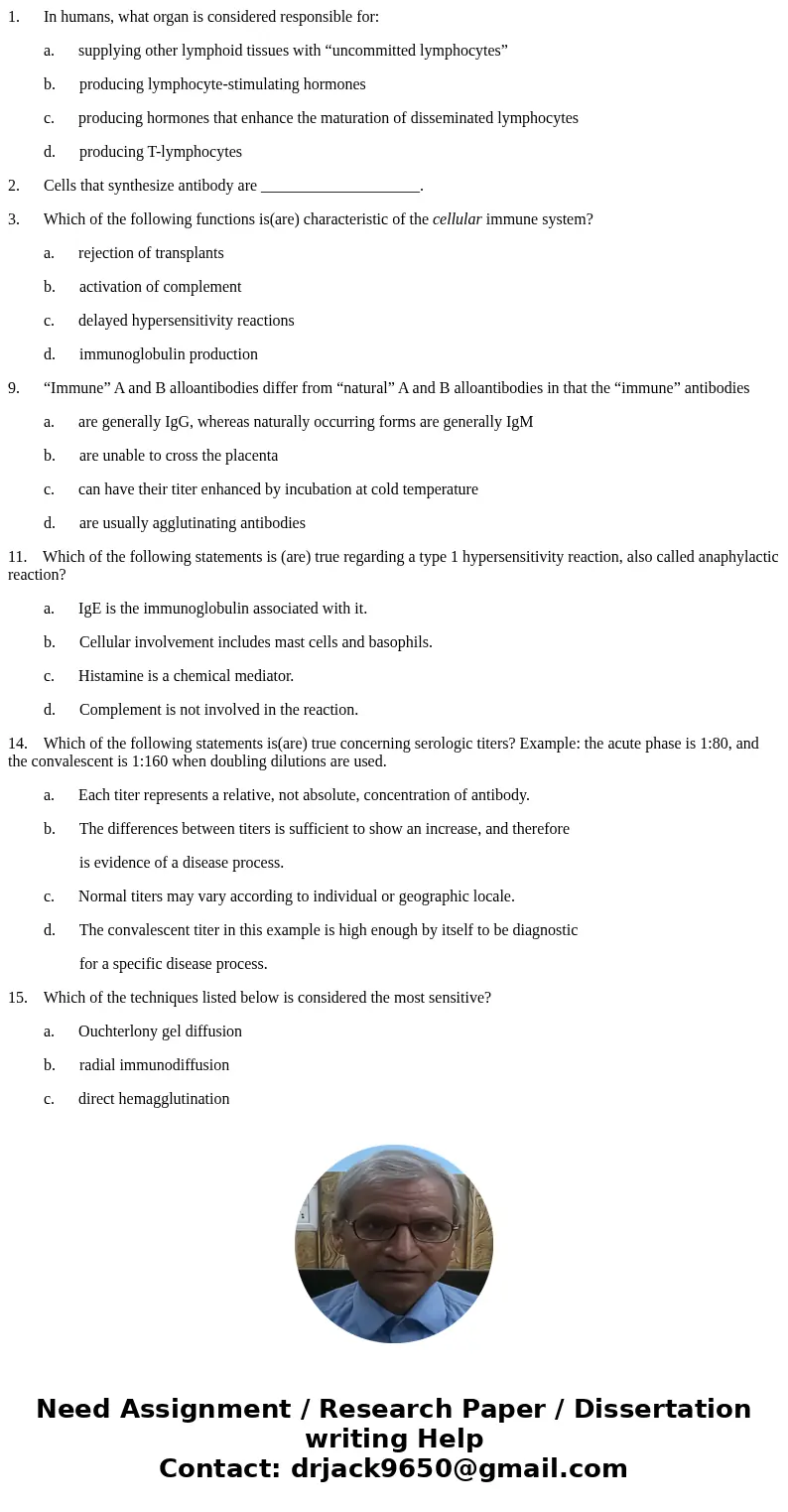
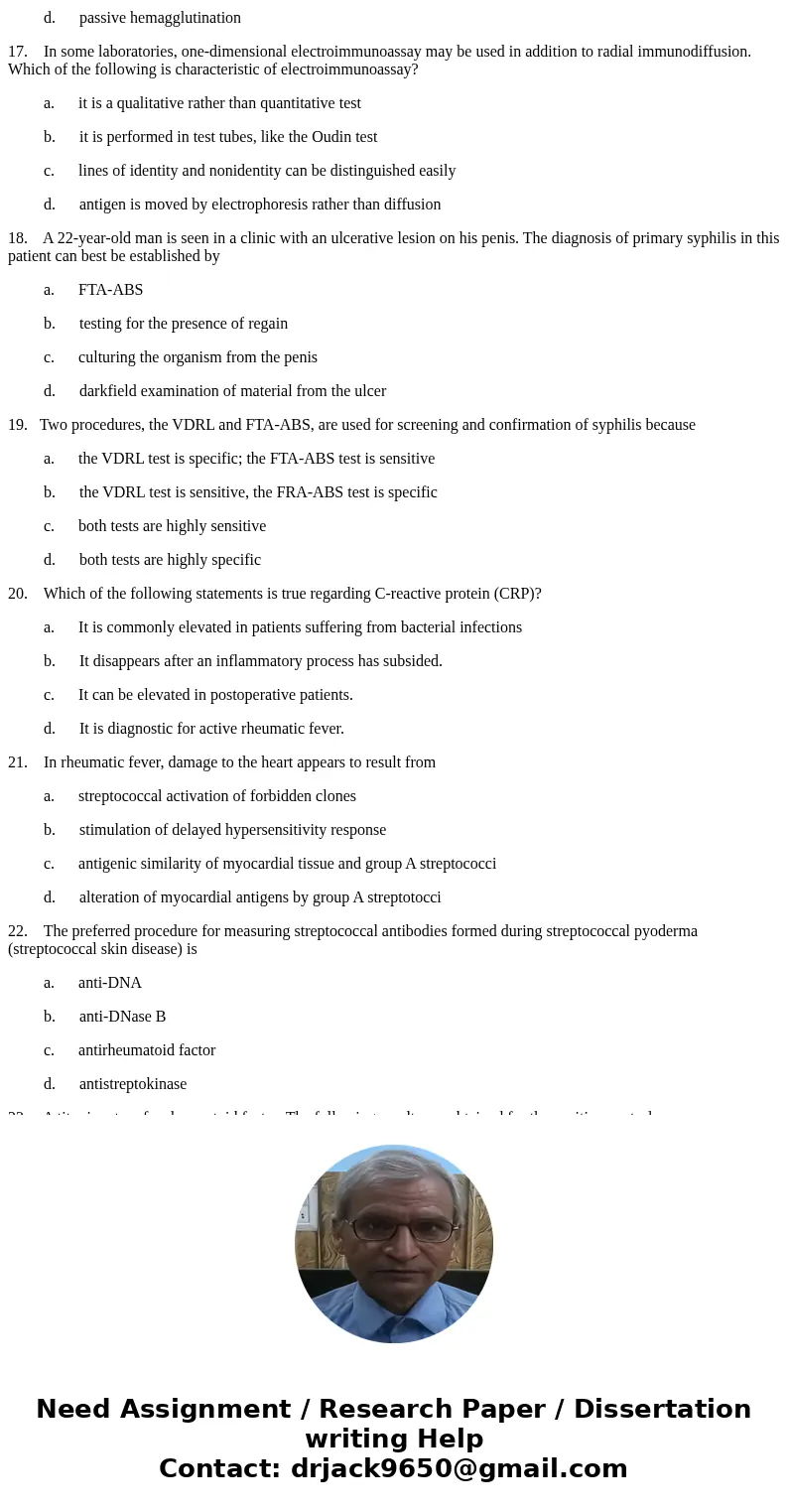
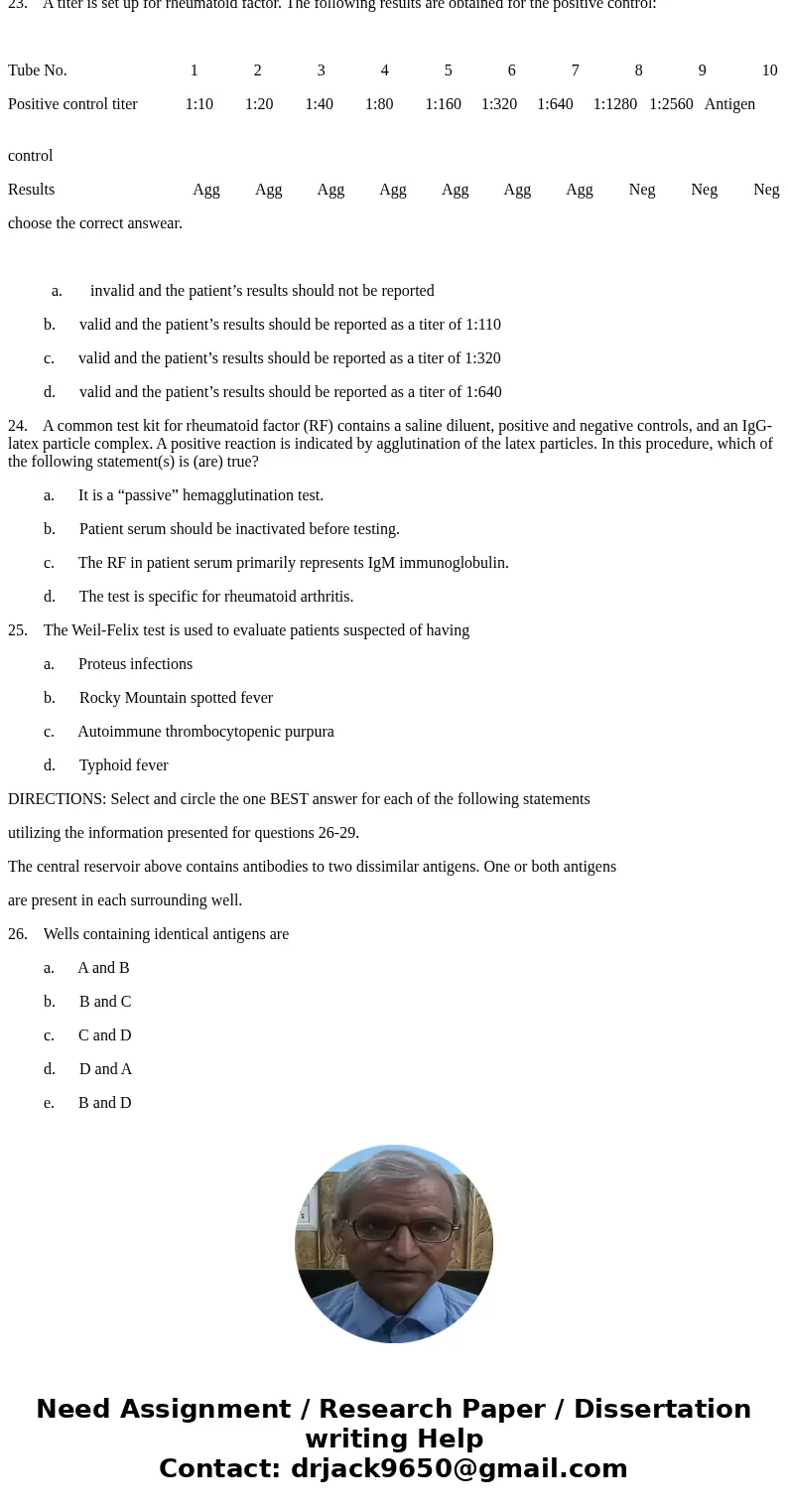
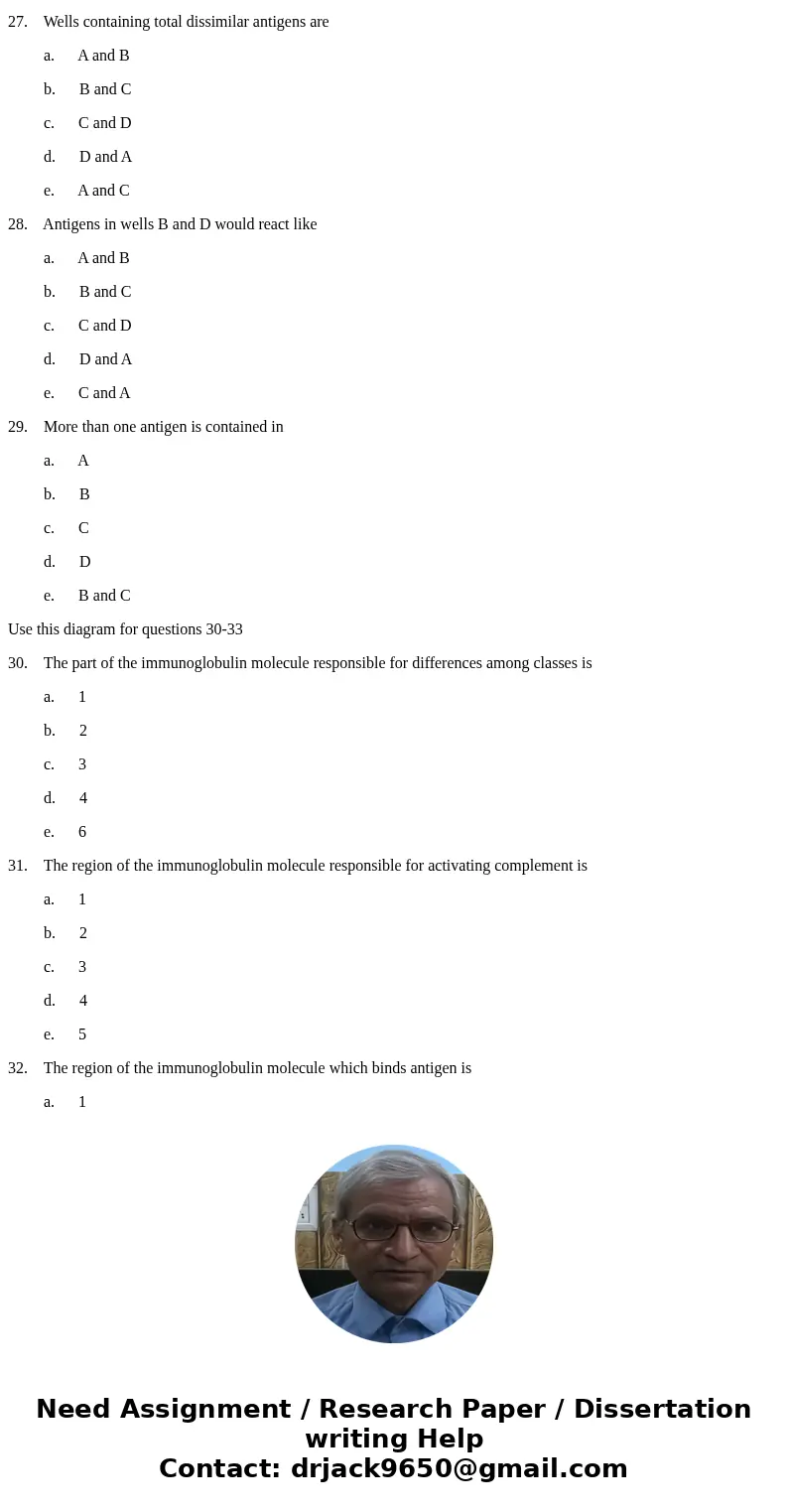
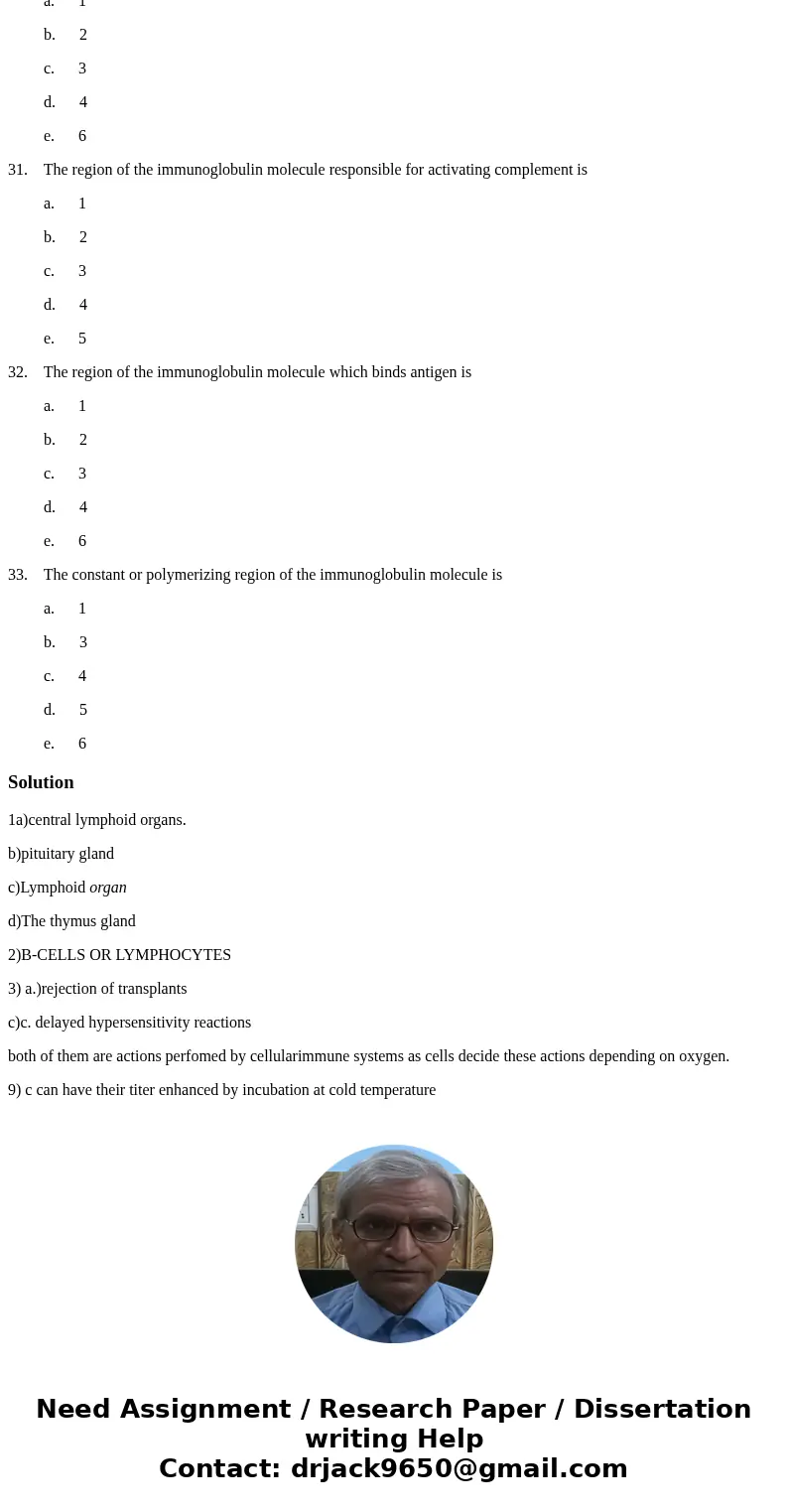
 Homework Sourse
Homework Sourse